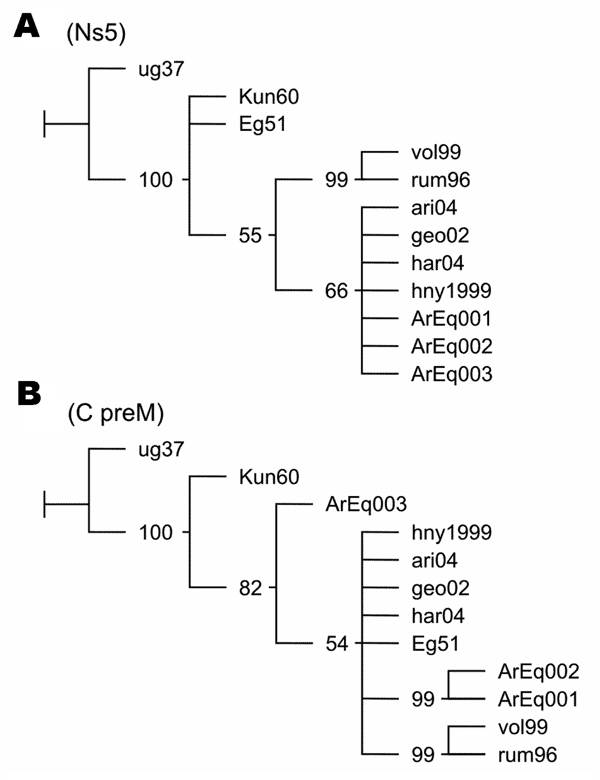Volume 12, Number 10—October 2006
Dispatch
West Nile Virus Isolation from Equines in Argentina, 2006
Figure 2

Figure 2. Phylogenetic trees of West Nile virus (WNV) nucleotide sequences. Maximum parsimony trees were obtained with TNT software (6). Values of jackknifing support are indicated at nodes. GenBank accession nos. ArEq001, ArEq002, and ArEq003: DQ537383, DQ537385, and DQ811782 (fragments NS5), DQ537382, DQ537384, and DQ811783 (fragments c/prM); ug37: M12294; vol99: AF317203, ari04: DQ164201; geo02: DQ164196; har04: DQ164206; hny1999: AF202541; Kun60: D00246; rum96: AF260969; Eg51:AF260968. A) NS5 fragment. B) C/preM fragment.
References
- Petersen LR, Roehrig JT. West Nile virus: a reemerging global pathogen. Emerg Infect Dis. 2001;7:611–4. DOIPubMedGoogle Scholar
- Beaty BJ, Calisher CH, Shope RS. Arboviruses. In: Schmidt NJ, Emmons RW, editors. Diagnostic procedures for viral, rickettsial and chlamydial infections. 6th ed. Washington: American Public Health Association; 1989. p. 797–856.
- Riggs JL. Immunofluorescent staining. In: Lennette EH, Schmidt NJ, editors. Diagnostic procedures for viral, rickettsial and chlamydial infections. 5th ed. Washington: American Public Health Association; 1979. p. 141–51.
- Shi PY, Kauffman EB, Ren P, Felton A, Tai JH, Dupuis AP II, High-throughput detection of West Nile virus RNA. J Clin Microbiol. 2001;39:1264–71. DOIPubMedGoogle Scholar
- Johnson DJ, Ostlund EN, Pedersen DD, Schmitt BJ. Detection of North American West Nile virus in animal tissue by a reverse transcription–nested polymerase chain reaction assay. Emerg Infect Dis. 2001;7:739–41. DOIPubMedGoogle Scholar
- Goloboff P, Farris S, Nixon K. TNT (tree analysis using new technology) (BETA) version 1.0. Tucuman, Argentina. Published by the authors; 2000.
- Komar N, Clark GG. West Nile virus activity in Latin America and the Caribbean. Rev Panam Salud Publica. 2006;19:112–7. DOIPubMedGoogle Scholar
- Mattar S, Edwards E, Laguado J, Gonzalez M, Alvarez J, Komar N. West Nile virus infection in Colombian horses. Emerg Infect Dis. 2005;11:1497–8.PubMedGoogle Scholar
- van der Meulen KM, Pensaert MB, Nauwynck HJ. West Nile virus in the vertebrate world. Arch Virol. 2005;150:637–57. DOIPubMedGoogle Scholar
Page created: November 10, 2011
Page updated: November 10, 2011
Page reviewed: November 10, 2011
The conclusions, findings, and opinions expressed by authors contributing to this journal do not necessarily reflect the official position of the U.S. Department of Health and Human Services, the Public Health Service, the Centers for Disease Control and Prevention, or the authors' affiliated institutions. Use of trade names is for identification only and does not imply endorsement by any of the groups named above.